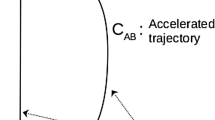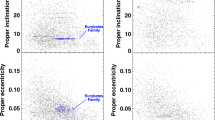Abstract
Dynamicalmass estimates for the main asteroid belt and the trans-Neptunian Kuiper belt have been found from their gravitational influence on the motion of planets. Discrete rotating models consisting ofmovingmaterial points have been used tomodel the total attraction fromsmall or as yet undetected bodies of the belts. The masses of the model belts have been included in the set of parameters being refined and determined and have been obtained by processing more than 800 thousand modern positional observations of planets and spacecraft. We have processed the observations and determined the parameters based on the new EPM2017 version of the IAA RAS planetary ephemerides. The large observed radial extent of the belts (more than 1.2 AU for the main belt and more than 8 AU for the Kuiper belt) and the concentration of bodies in the Kuiper belt at a distance of about 44 AU found from observations have been taken into account in the discrete models. We have also used individual mass estimates for large bodies of the belts as well as for objects that spacecraft have approached and for bodies with satellites. Our mass estimate for the main asteroid belt is (4.008 ± 0.029) × 10−4/m⊕ (3σ). The bulk of the Kuiper belt objects are in the ring zone from 39.4 to 47.8 AU. The estimate of its total mass together with the mass of the 31 largest trans-Neptunian Kuiper belt objects is (1.97 ± 0.30) × 10−2m⊕ (3σ), which exceeds the mass of the main asteroid belt almost by a factor of 50. The mass of the 31 largest trans-Neptunian objects (TNOs) is only about 40% of the total one.
Similar content being viewed by others
References
R. L. Allen, G. M. Bernstein, and R. Malhotra, Astron. J. 124, 2949 (2002).
M. T. Bannister, J. J. Kavelaars, J.-M. Petit, B. J. Gladman, S. D. J. Gwyn, Y.-T. Chen, K. Volk, M. Alexandersen, et al., Astron. J. 152, 70 (2016).
G. Benedetti-Rossi, R. Vieira Martins, J. I. B. Camargo, M. Assafin, and F. Braga-Ribas, Astron. Astrophys. 570, A86 (2014).
G. M. Bernstein, D. E. Trilling, R. L. Allen, M. E. Brown, M. Holman, and R. Malhotra, Astron. J. 128, 1364 (2004).
M. Booth, M. C. Wyatt, and A. Morbidelli, Mon. Not. R. Astron. Soc. 399, 385 (2009).
M. Buie and W. M. Folkner, Astron. J. 149, 22 (2015).
E. I. Chiang and M. E. Brown, Astron. J. 118, 1411 (1999).
A. Delsanti and D. Jewitt, in Solar System Update, Ed. P. Blondel and J. Mason (Springer, Berlin, 2006), p. 267.
J. L. Elliot, S. D. Kern, K. B. Clancy, A. A. S. Gulbis, R. L. Millis, M. W. Buie, L. H. Wasserman, E. I. Chiang, et al., Astron. J. 129, 1117 (2005).
W. M. Folkner, J. G. Williams, D. H. Boggs, R. S. Park, and P. Kychynka, IPN Prog. Rep. 42–196 (2014).
B. Gladman, Highlights Astron. 12, 193 (2002).
B. Gladman, J. J. Kavelaars, J.-M. Petit, A. Morbidelli, M. J. Holman, and T. Loredo, Astron. J. 122, 1051 (2001).
A. Hees, W. Folkner, R. Jacobson, and R. Park, Phys. Rev. D 89, 102002 (2014).
D. Jewitt, J. Luu, and C. Trujillo, Astron. J. 115, 2125 (1998).
S. Kenyon, Publ. Astron. Soc. Pacif. 114, 265 (2002).
S. J. Kenyon and J. Luu, Astron. J. 118, 1101 (1999).
G. A. Krasinsky, E. V. Pitjeva, M. V. Vasilyev, and E. I. Yagudina, Icarus 158, 98 (2002).
P. Kuchynka and W. Folkner, Icarus 222, 243 (2013).
H. F. Levison and A. Morbidelli, Nature (London, U. K. ) 426, 419 (2003).
J. X. Luu and D. C. Jewitt, Ann. Rev. 40, 63 (2002).
N. McBride and D. W. Hughes, Mon. Not. R. Astron. Soc. 244, 513 (1990).
R. S. Park, W. M. Folkner, A. S. Konopliv, J. G. Williams, D. E. Smith, and M. T. Zuber, Astron. J. 153, 121 (2017).
D. A. Pavlov and V. I. Skripcnichenko, in Proceedings Journees 2014 on Systemes de Reference Spatio-Temporels, Ed. by Z. Malkin and N. Capitaine (Pulkovo Observ., 2015), p. 243.
D. A. Pavlov, J. G. Williams, and V. V. Suvorkin, Celest. Mech. Dyn. Astron. 126, 61 (2016).
J.-M. Petit, A. Morbidelli, and J. Chambers, Icarus 153, 338 (2001).
E. V. Pit’eva, N. P. Pit’ev, D. A. Pavlov, and M. A. Bodunova, Tr. IPA RAN 43, 113 (2017).
E. V. Pitjeva, Solar Syst. Res. 39, 176 (2005).
E. V. Pitjeva, in Proceedings of the IAU Symposium 263 on Icy Bodies of the Solar System, Ed. by D. Lazzaro, D. Prialnik, R. Schulz, and J. A. Fernandez (Cambridge Univ. Press, Cambridge, 2010a), p. 93.
E. V. Pitjeva, in Protecting the Earth against Collisions with Asteroids and Comet Nuclei, Ed. by A. Finkelstein, W. Huebner, and V. Shor (Nauka, St. Petersburg, 2010b), p. 237.
E. V. Pitjeva, Solar Syst. Res. 47, 386 (2013).
E. V. Pitjeva and N. H. Pitjev, Celest. Mech. Dyn. Astron. 119, 237 (2014).
E. V. Pitjeva and N. H. Pitjev, in Proceedings of the IAU Symp. No. 318 on Asteroids: New Observations, New Models, Ed. by S. Chesley, A. Morbidelli, R. Jedicke, and D. Farnocchia (Cambridge Univ. Press, Cambridge, 2016), p. 212.
M. C. de Sanctis, M. T. Capria, and A. Coradini, Astron. J. 121, 2792 (2001).
S. A. Stern and J. E. Colwell, Astrophys. J. 490, 879 (1997).
C. A. Trujillo and M. E. Brown, Astrophys. J. 554, L95 (2001).
T. Vinogradova, Tr. IPA RAN 26, 110 (2012).
C. Vitense, A. Krivov, and T. Lohne, Astron. Astrophys. 520, A32 (2010).
P. R. Weissman and H. F. Levison, Ed. by A. Stern and D. J. Tholen (Univer. Arizona Press, Tucson, 1997), p. 559.
Author information
Authors and Affiliations
Corresponding author
Additional information
Original Russian Text © E.V. Pitjeva, N.P. Pitjev, 2018, published in Pis’ma v Astronomicheskii Zhurnal, 2018, Vol. 44, Nos. 8–9, pp. 604–617.
Rights and permissions
About this article
Cite this article
Pitjeva, E.V., Pitjev, N.P. Masses of the Main Asteroid Belt and the Kuiper Belt from the Motions of Planets and Spacecraft. Astron. Lett. 44, 554–566 (2018). https://doi.org/10.1134/S1063773718090050
Received:
Published:
Issue Date:
DOI: https://doi.org/10.1134/S1063773718090050




